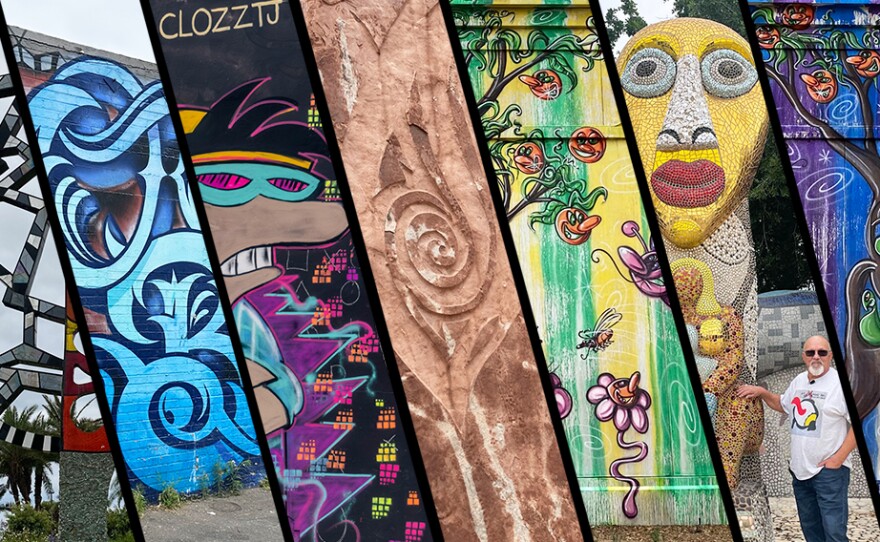Editor's note: This story contains crude language.
Evan Apodaca had just spent the day installing his public art video piece near Gate 48 at the San Diego International Airport in February when a nearby man gave a foreboding appraisal of the work.
“He stood and watched the whole thing, and when he was done, he asked me, ‘Are you the artist?’ and I said, ‘Yeah,’” Apodaca recalled. “And he said, ‘Well, this is woke bullshit.’”
The artwork that elicited the commentary is entitled “Monumental Interventions.” It challenges the value of the military presence in San Diego and questions whether the armed forces should even be honored, using the voices of local residents emanating from the toppled, beheaded statues of international and local political figures.
For example, in one part, an animated decapitated bust of former British Prime Minister Margaret Thatcher mouths the question, “Do we want to continue to create an economy that believes in death and destruction ... or, do we want to create industries that support sustainable development?”
One month after Apodaca installed his artwork, he said the airport removed it without warning or explanation. It was only after Apodaca tweeted out about the removal that he said airport officials contacted him for a face-to-face meeting.
“They said, ‘Evan, your project was not the same as what you had proposed,’” Apodaca said.

Airport officials declined an interview with KPBS. In a written statement, airport spokesperson Nicole Hall wrote that Apodaca’s video piece was brought down “because the artwork delivered by the artist did not match the proposal that had been previously approved by the Arts Program.”
But Apodaca contends officials gave him other reasons.
“They said the person that had made the comment to me about the artwork being woke bullshit was the same person whose comments had gone all the way up to government-appointed officials who run the airport, who then told everyone below them in the art department to do something about this,” Apodaca said.
The controversy over Apodaca’s work is just the latest in a string of debates over public art in the San Diego region, from the “Split Pavilion sculpture” in Carlsbad to the “Kiss Statue” at the Port of San Diego to more recent examples.
Last year, the city of Chula Vista permanently removed a Christopher Columbus statue from Discovery Park. The park was also renamed Kumeyaay Park of Chula Vista.
Also last year, some outraged Escondido residents wanted an exhibit named “Three Slick Pigs” to be removed. It featured pig statues in police uniforms dancing.
And activists have long pushed for the city of San Diego to take down a statue of former Governor Pete Wilson because of his support in 1994 for Prop. 187, which was meant to withhold government services to undocumented people.
Both the pig display and the Wilson statue remained.
Elizabeth Larison, director of the New York-based Arts and Culture Advocacy Program with the National Coalition Against Censorship, said resisting artistic censorship is especially important amid today’s deep political divide.
“We feel that we need to fight to protect access to works that contribute to the full cornucopia of the ideas that contribute to a shared culture,” Larison said. “A culture that is vibrant. It's messy. It's heterogeneous. It's democratic.”
Larison conducted her own review of the San Diego Airport’s dealings with Apodaca and argued that airport officials failed to protect his work. Apodaca submitted excerpts of the piece to the airport before officials selected it for installation. At least one of the samples included a decapitated statue animated with a voice critical of the military in San Diego.
Larison believes airport officials chose Apodaca’s work as part of its exhibit called “A Necessary Departure” for its creativity, artistic merit, cultural significance and educational value.
In an email to Apodaca sent last fall, Daniel Dennert, curator for the airport’s arts program, appeared to make a similar point. Dennert told Apodaca his work resonated with the airport’s concept.
“The panel felt your work was connected to our theme by the way we choose, or not to [sic] choose, to listen to things around us and how they inform our future,” the email read.
Apodaca said airport staff never asked him to submit the final piece before he installed it in February. Larison said if he had, it’s unlikely the outcome would have been different.
“The visual and the artistic aspects are all very much still there and are not compromised,” Larison said. “And yet the main difference is a slightly more critical viewpoint, which is explored through the voices.”
And that’s why she describes the airport’s takedown of Apodaca’s art as “viewpoint discrimination.”
“This is a case of censorship,” Larison said.
However, she said it’s a tough allegation to prove because the contract between Apodaca and the airport was written so that either party can terminate it at any time for any reason.
“This is the loophole that allows the airport to withdraw the work in a way that kind of protects them from a censorship accusation,” Larison said.
Free speech, arts and culture consultant Svetlana Mintcheva said the current sociopolitical divisions have resulted in increased calls to censor art by removing it from museums and public spaces. She said airport officials were right to take note of the man who complained about Apodaca’s work. But she believes they then misstepped.
“The calls to remove work should be responded to,” Mitcheva said. “But responded to in a different way, responded to with more conversation, responded to, with, say a meeting with the artist, not by suppressing the artwork.”
Apodaca said he doesn’t want to criticize airport officials. But he believes something was lost with his art’s removal.
“We need artwork that challenges us in the public,” he said. “It shouldn't be hiding.”
He said he is hopeful the piece will eventually be displayed elsewhere.








